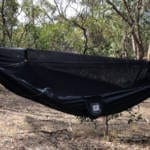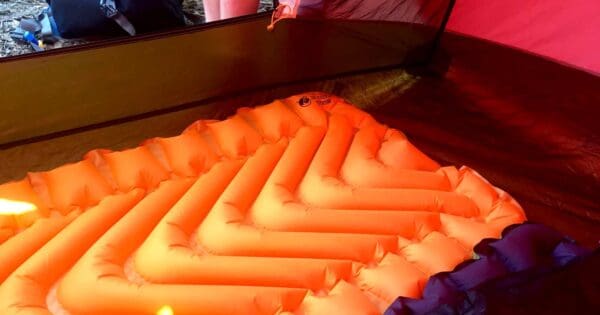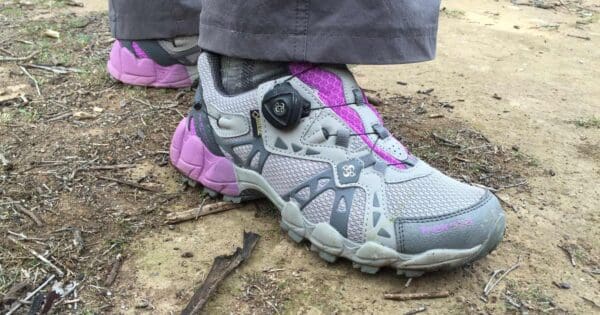Field test and review – Rainshadow jacket
You have probably heard the saying, there is no such thing as poor weather, just poor gear and poor preparation. I have always found this to be so very true when it comes to outdoor pursuits and have often enjoyed amazing hikes into the worst weather you could imagine. On the flip-side, I have also had the worst experiences in the worst weather you can imagine, simply because I did not have the right gear, or I did have the right gear but had not cared for it correctly. Such as my $800 GORE-TEX jacket that I didn’t realise I had to continue to seal. You only make those mistakes once.
You might be expecting perfect weather, a gentle shower or a torrential downpour, despite your expectations I encourage you to always carry a rain jacket in your pack as they are useful for wet weather and as a wind breaker to keep you warm.
Waterproof jackets (or outer shells as they are also known) are the final protective layer in your layering system. This outer layer provides a very important windproof and waterproof barrier, protecting you from a mild drizzle and gentle breeze to an epic downpour and gusting winds.
When researching your next outer shell, the main difference you will note between styles is the fabric they are made from and the level of breathability and protection from the elements that this fabric provides.
The level of breathability you need is dependent on your chosen activity:
- High aerobic activities (such as mountain climbing and steep-hill hiking) necessitate the use of highly breathable fabrics.
- Less arduous activities (such as day to day use, or gently undulating hikes) require a less breathable garment.
Over the years I have carried every kind of jacket in my pack in case of inclement weather. From the old style hard shell plastic waterproof rain jackets (you know the ones, the style that make you sweat so much that you often end up wetter inside the jacked that it is outside) to water resistant insulated shells, hybrid shells, soft shells and the more modern waterproof hard shell (often containing GORE-TEX) which are able to provide surprisingly increased breathability to their predecessor.
I should point out that no jacket is able to be completely waterproof as well as breathable. To be completely waterproof the garment essentially needs to be manufactured from plastic bags and you can’t wear one of those without sweat condensing on the inside of the garment. Or can you?
To provide you with the best balance of breathability and waterproofing, membranes and coatings have been developed which keep water while allowing water vapour (perspiration) to pass through. The trick is to find the right balance as the more you have of one the less you have of the other.
The differences explained
We call a jacket ‘waterproof’ when its water resistance is enough to keep out driving rain. Though companies disagree on test standards, you can trust that any gear that a major brand designates as ‘waterproof’ can stand up to a serious squall.
Waterproof/breathable: This type of performance rainwear keeps rain from getting through to your skin, while also moving perspiration back through to the outside world. If you’re planning any activity that gets limbs and lungs pumping, this is your kind of gear you need because both precipitation and perspiration can leave you soaking wet.
Water-resistant: Also, breathable, this gear can handle light rain for a brief time—windbreakers and featherweight jackets, for example. If precipitation lingers or starts coming down sideways, these won’t stand up to the task.
Waterproof/nonbreathable: Think emergency poncho. If you simply need to keep the rain out while sitting or standing around, this gear does just fine—and costs very little money. They also come on styles now that will allow you to completely cover your pack. If you do exert yourself though, your poncho will be wet inside, too. And it won’t take much wind to make a poncho largely ineffective.
With all the gear I have field-tested over the years, I thought I had seen it all in terms of fabric innovation. That was until I received a copy of a press release from Patagonia announcing their upcoming winter 2019 Recycled Rainwear Collection with the key point of difference being the use of recycled materials. The use of recycled materials for clothing manufacture is not new as only six months ago I received a press release about a range of clothing that was manufactured from recycled plastic bottles. Pretty cool innovations.

What is different with Patagonia’s Recycled Rainwear Collection is that in classic Patagonia style, this line harnesses a mission to reduce their impact on the environment – built with 3 different shells ranging from entry level to highly technical. This range of reliable, packable and versatile rainwear is made from Econyl nylon yarns from discarded fishing nets, GORE-TEX Paclite Plus, Eco Circle polyester and 100% recycled nylon face fabric. That’s right, you read that correctly, discarded fishing nets.
I must applaud Patagonia for their mission. Did you know that fishing nets account for 46 Percent of ALL ocean plastic? It’s worth noting that miscellaneous discarded fishing gear makes up the majority of the rest. World Animal Protection (WAP) reports that 700,000 tons of gear are lost and pollute oceans each year. If that is not alarming enough, the plastics that make up most of the nets in the oceans today take around 600 years to break apart.
So well done Patagonia for your innovative and environmentally conscious approach.
I was excited to be sent a Patagonia Men’s Stretch Rainshadow Jacket to field-test and review so without further ado, here is what I discovered.
The Rainshadow Jacket is a lightweight waterproof rain jacket made utilising a 100% recycled face fabric and has all the essential features needed to stay moving when the weather turns. Weighing close to 300 grams (Men’s Large), the Jacket is light, stretchy, extremely packable and comes with all the bells and whistles you’d expect on an outer shell in today’s gear rich market.

From the head down, the Rainshadow is equipped with an alpine helmet–compatible hood which is perfect for the winter months when you are scaling a summit with ice-axe in hand. The laminated visor does a great job of preventing the rain from dripping onto your face and comes complete with single-pull adjustment rolls down and stows with a simplified cord-and-hook design. I am used to all my other jackets having dual-pull adjustments either side of the hood so I must confess, it took me a few minutes to work out that the single-pull was located at the back of my head. I had to take the jacket off initially to work out how to tighten the hood correctly. One I knew, it was a breeze from that point on.

The front of the jacket is a zipper style and fashions a coated, watertight centre-front zipper. Under the arm pits you will find welted venting pit zips, designed to regulate the temperature inside the jacket. These vents are invaluable when you are active on the trail as they allow body heat to escape from an area where it builds up quickly, reducing perspiration inside the jacket. All zippers are treated with a DWR (durable water repellent) finish to help prevent rain from penetrating the zips. The front zipper has a fold-over rain flap to keep water off the zipper and can be zipped up over your chin to keep water off your face in blowing rain or cold wind off your face in cooler climates.

The Rainshadow jacket has two exterior hand-warmer pockets and one welted exterior left-chest pocket. These pockets are all quite large and can easily carry items such as electronic devices, gloves, beanie etc. When wearing this jacket with a pack, I found the zippers were large enough that I could still gain access to the pockets while wearing a backpack hip belt. This is an often-overlooked feature. The welted chest pocket has a DWR (durable water repellent)-treated zipper while the two hand-warmer pockets have coated, watertight zippers. One really cool feature is that when not in use, the jacket self-stuffs into the chest pocket, exposing a carabiner clip-in loop for easily securing to your pack. With or without the use of the stuff-sack, the jacket will pack down small enough to ‘almost’ fit in the palm of your hand. What this means is that this jacket should remain in your pack for every hike you undertake as it takes up barely any space.

When wearing an outer shell, whether it be for rain or wind protection, it is important to be able to keep the elements out. I love the fact this jacket has self-fabric hook-and-loop cuff closures with large enough tabs that you can easily grasp the cuff closure while wearing gloves to adjust as needed for protection and ventilation. The hem of the jacket also has a dual-adjust drawcord to help seal the weather out.

I’ve worn this jacket in everything from freezing (sub-zero) wind to heavy thunderstorms and it appears to do a great job of preventing the elements from penetrating through to my mid layers. When rain falls on the surface of the jacket, it beads and rolls off as you’d expect, rather than soaking the fabric and chilling your skin. When the sun comes out, a quick shake of the jacket leaves it feeling quite dry again. The fact that the Rainshadow Jacket has its own 2.5-layer waterproof/breathable membrane, means that you never have to worry about this jacket wetting-out, the most common point of failure for rain jackets made using waterproof-breathable fabrics.

This jacket’s breathability ensures that it doesn’t retain a lot of heat when you’re active or allow it to escape in cold weather. I generally start to perspire when the temperature reaches 20 degrees or higher, with or without rain and it was great to be able to regulate my temperature using the arm pit vents and adjustable hem and cuffs. There is nothing more uncomfortable than becoming wetter inside your clothing due to heat than what is pouring down external to your clothing.
As with all my reviews, I have worn this jacket on at least four day-hikes before preparing the review. As such it is difficult to talk about product durability at this early stage. The jacket has been manufactured using 100% recycled nylon stretch ripstop so I would like to trust that it will stand up to the brutality of the Australian bush. Check back in a few months as I will update the review if I believe that durability needs to be addressed.
If you are in the market for a light, supple, stretchy, fashionable and environmentally conscious outer shell, I encourage you to check out Patagonia Recycled Rainwear Collection. This jacket has found a home in my pack.

Buy direct from Patagonia for $279.95
(Patagonia Men’s Stretch Rainshadow Jacket)
Tech Specs
- H2No® Performance Standard shell: 2.5-layer, 2.2-oz 30-denier ECONYL® 100% recycled nylon stretch ripstop with a waterproof/breathable barrier and a DWR (durable water repellent) finish





